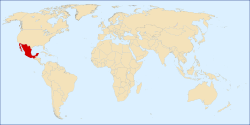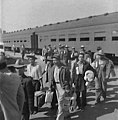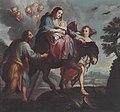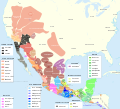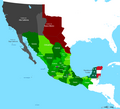Portal:Mexico
|
The Temple of Warriors at Chichen Itza, Mexico
¡Bienvenido! Welcome to the Mexico portal
Mexico, officially the United Mexican States, is a country in the southern portion of North America. It covers 1,972,550 km2 (761,610 sq mi), making it the world's 13th-largest country by area; with a population of almost 130 million, it is the 10th-most-populous country and the most populous Spanish-speaking country. Mexico is organized as a federal constitutional republic comprising 31 states and Mexico City, its capital. It shares land borders with the United States to the north, with Guatemala and Belize to the southeast; as well as maritime borders with the Pacific Ocean to the west, the Caribbean Sea to the southeast, and the Gulf of Mexico to the east.
This is a Featured article, which represents some of the best content on English Wikipedia.
The Grass Fight was a small battle during the Texas Revolution, fought between the Mexican Army and the Texian Army. The battle took place on November 26, 1835, just south of San Antonio de Béxar in the Mexican region of Texas. The Texas Revolution had officially begun on October 2 and by the end of the month the Texians had initiated a siege of Béxar, home of the largest Mexican garrison in the province. Bored with the inactivity, many of the Texian soldiers returned home; a smaller number of adventurers from the United States arrived to replace them. After the Texian Army rejected commander-in-chief Stephen F. Austin's call to launch an assault on Béxar on November 22, Austin resigned from the army. The men elected Edward Burleson their new commander-in-chief. On November 26, Texian scout Deaf Smith brought news of a Mexican pack train, accompanied by 50–100 soldiers, that was on its way to Bexar. The Texian camp was convinced that the pack train carried silver to pay the Mexican garrison and purchase supplies. Burleson ordered Colonel James Bowie to take 45–50 cavalry and intercept the train. An additional 100 infantry followed. On seeing the battle commence, Mexican General Martín Perfecto de Cos sent reinforcements from Bexar. The Texans repulsed several attacks by Mexican soldiers, who finally retreated to Bexar. When the Texians examined the abandoned pack train they discovered that, instead of silver, the mules carried freshly cut grass to feed the Mexican Army horses. Four Texians were injured, and historian Alwyn Barr states that three Mexican soldiers were killed, although Bowie and Burleson initially claimed the number was much higher. (Full article...)Selected article -
A radioactive contamination incident occurred in 1984 in Ciudad Juárez, Mexico, originating from a radiation therapy unit illegally purchased by a private medical company and subsequently dismantled for lack of personnel to operate it. The radioactive material, cobalt-60, ended up in a junkyard, where it was sold to foundries that inadvertently melted it with other metals and produced about 6,000 tons of contaminated rebar. These were distributed in 17 Mexican states and several cities in the United States. It is estimated that 4,000 people were exposed to radiation as a result of this incident. (Full article...)
Selected picture Mural by Diego Rivera, of the Pre-Columbian Aztec city of Tenochtitlan.Palacio Nacional, Mexico City. image credit: Wolfgang Sauber/freedom of panorama
This is a Good article, an article that meets a core set of high editorial standards.
Todos Los Romances (All the Romances) is a box set compilation album by Mexican singer Luis Miguel. Released on 11 August 1998 by WEA Latina, the record features the three previously released Romance-themed albums in which Miguel covered classic boleros in each of them: Romance (1991), Segundo Romance (1994), and Romances (1997). An editor for AllMusic rated the album four of five stars. Commercially, Todos Los Romances peaked at number four in Spain and was certified double Platinum in the country. It also achieved Gold status in Argentina and peaked at number 12 on the Billboard's Top Latin Albums in the United States. (Full article...) Selected biography -Francisco "Pancho" Villa (/ˈviːə/ VEE-ə, also US: /ˈviːjɑː/ VEE-yah; Spanish: [ˈbiʎa]; born José Doroteo Arango Arámbula, 5 June 1878 – 20 July 1923) was a Mexican revolutionary and general in the Mexican Revolution. He was a key figure in the revolutionary movement that forced out President Porfirio Díaz and brought Francisco I. Madero to power in 1911. When Madero was ousted by a coup led by General Victoriano Huerta in February 1913, Villa joined the anti-Huerta forces in the Constitutionalist Army led by Venustiano Carranza. After the defeat and exile of Huerta in July 1914, Villa broke with Carranza. Villa dominated the meeting of revolutionary generals that excluded Carranza and helped create a coalition government. Emiliano Zapata and Villa became formal allies in this period. Like Zapata, Villa was strongly in favor of land reform, but did not implement it when he had power. At the height of his power and popularity in late 1914 and early 1915, the U.S. considered recognizing Villa as Mexico's legitimate authority. Civil war broke out when Carranza challenged Villa. Villa was decisively defeated by Constitutionalist general Álvaro Obregón in summer 1915, and the U.S. aided Carranza directly against Villa in the Second Battle of Agua Prieta in November 1915. Much of Villa's army left after his defeat on the battlefield and because of his lack of resources to buy arms and pay soldiers' salaries. Angered at the U.S. aid to Carranza, Villa conducted a raid on the border town of Columbus, New Mexico to goad the U.S. into invading Mexico in 1916. Despite a major contingent of soldiers and superior military technology, the U.S. failed to capture Villa. When Carranza was ousted from power in 1920, Villa negotiated an amnesty with interim President Adolfo de la Huerta and was given a landed estate, on the condition he retire from politics. Villa was assassinated in 1923. Although his faction did not prevail in the Revolution, he was one of its most charismatic and prominent figures. (Full article...)
In the news
Selected fare or cuisine - Aztec cuisine is the cuisine of the former Aztec Empire and the Nahua peoples of the Valley of Mexico prior to European contact in 1519. The most important staple was corn (maize), a crop that was so important to Aztec society that it played a central part in their culture. Just like wheat in much of Europe or rice in most of East Asia, it was the food without which a meal was not a meal. It came in varieties that differed in color, texture, size and prestige, and was eaten as corn tortillas, tamales or ātōlli, maize gruel. The other constants of Aztec food were salt and chili peppers and the basic definition of Aztec fasting was to abstain from these two. (Full article...)
General imagesThe following are images from various Mexico-related articles on Wikipedia.
CategoriesTopicsRelated portalsWikiProjectYou are invited to participate in WikiProject Mexico, a WikiProject dedicated to developing and improving articles about Mexico. Associated WikimediaMore portals | ||||||||||




